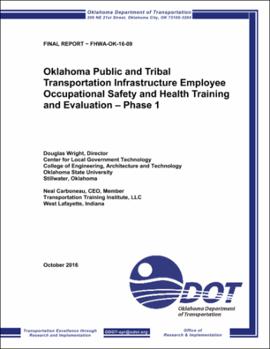| dc.creator | Wright, Douglas | |
| dc.creator | Carboneau, Neal | |
| dc.date.accessioned | 2018-01-30T16:25:42Z | |
| dc.date.available | 2018-01-30T16:25:42Z | |
| dc.date.issued | 2016-10 | |
| dc.identifier.govdoc | FHWA-OK-16-09 | |
| dc.identifier.other | Oklahoma Department of Transportation State Planning and Research item number 2300(16-03) | |
| dc.identifier.uri | https://hdl.handle.net/11244/54333 | |
| dc.description.abstract | The objective of this project was to reduce the number and severity of incidents to Oklahoma’s public and tribal sector workforce that has responsibilities for working on the road while gaining a better understanding of the need for worker safety training to help drive future decision making processes. The need was to be identified through the participants’ understanding of basic hazards and prevention measures in their workplace using OSHA’s 10 Hour Outreach Training Program customized under FHWA’s Work Zone Safety Grant by ARTBA in conjunction with the Roadway Safety Consortium for the roadway industry. The course was further customized during this project to more closely meet the needs of the specific participants relating to their activities in infrastructure management. Audience response systems were used to allow for participant assessment, survey, engagement, evaluation and post training perspective. The results provide both a quantitative and qualitative impact of the participants’ understanding of basic course information. The participants’ average pretest score was 57% and their perspective on their understanding of the content prior to the course was an average score of 62%. The average post test score was 86% with a post course perspective on their understanding of 84%. The course and instructor rating of 4.54 out of 5 also identifies the quality and impact of the training. A post training follow up by TTI-LLC, independent of this research showed 1 in 4 participants of a similar course surveyed one year following training indicated that they thought about the information contained in the course often. Approximately one in three thought that the course provided a definite improvement of safety on their jobs. The final component of the project was to identify future needs; and, based on course discussions and data collected, advanced temporary traffic control training was identified as a need for the participants targeted for this training. | |
| dc.format.extent | 85 pages | |
| dc.format.extent | 6,825,307 bytes | |
| dc.format.medium | application.pdf | |
| dc.language | en_US | |
| dc.relation.ispartofseries | No | |
| dc.relation.requires | Adobe Acrobat Reader | |
| dc.title | Oklahoma Public and Tribal Transportation Infrastructure Employee Occupational Safety and Health Training and Evaluation – Phase 1 (FHWA-OK-16-09 2300(16-03)) | |
| dc.type | Technical Report | |
| dc.description.version | Final report, October 2012-December 2013 | |
| dc.description.peerreview | No | |
| dc.type.material | text | |
| dc.subject.keywords | Training | |
| dc.subject.keywords | occupationalsafety | |
| dc.subject.keywords | work zone safety | |
| dc.subject.keywords | highway traffic control | |
| dc.contributor.sponsor | Oklahoma Department of Transportation. Materials and Research Division. Office of Research & Implementation | |
